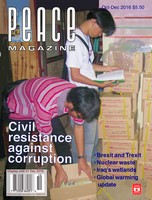
Peace Magazine Oct-Dec 2016, page 30. Some rights reserved.
Search for other articles by Subir Guin here
By A. Walter Dorn. International Peace Institute, 2016. Free download at ipinst.org.
UN-bashing is a popular topic of conversation in some circles and unfortunately widespread among readers who rely solely on mainstream media for information. The US stands out as one of the United Nations’ fiercest critics— and its biggest financial contributor!
Several of its ambassadors have been on record, publicly attacking its policies/ decisions, even though they are made in committee by member states, representing up to 135 nations.
To be fair, such criticism is sometimes justified; but if we take a closer look at how the many agencies under this international body operate, as this author attempts to do, one gets a better understanding of the enormous challenges, and extraordinary demands on the personnel tasked to fulfil their mission.
Walter Dorn’s long association with United Nations’ peacekeeping operations, and his extensive background in science, qualify him to report on its strengths and shortcomings. Additionally, he offers recommendations on how new technologies currently in the market could greatly enhance the effectiveness of peacekeeping missions, provide better security for their staff, and improve communications linking outposts and command headquarters.
Whether monitoring conflicts, sanctions, border security, or protecting civilians from hostile elements, UN personnel need to be equipped with the means to monitor, defend, and report back to headquarters. They also need to be self-reliant in keeping their equipment working and in good repair, especially in remote or isolated regions.
While the UN has developed world-class capability in information and communications technology, they face interoperability problems when teams of peacekeepers drawn from different countries find their systems often incompatible with those of others. Phasing in a universal system would be the ideal solution in the long run.
The UN has very little experience in R & D when it comes to new technologies, but this where tech-contributing member states can provide valuable advice. The author cautions against adopting the latest and “shiniest” systems, which may not be the most appropriate. Another factor to be considered is the time it takes to train personnel before new equipment is introduced.
Other suggestions for better equipment include for example, the use of night-vision binoculars, drones fitted with high-resolution cameras (capable of detecting movement, explosives or contraband), solar-powered chargers, and so forth. Certain member states have the knowledge and experience to advise on the technological options available, while others contribute personnel—troops or police—as required. In 2006, Walter Dorn was commissioned by the UN Department of Peacekeeping Operations (DPKO) to conduct a study on technologies for peacekeeping and various Security Council mandates. His report was welcomed by the committee, drawn from 124 member states currently involved in these operations.
This paper gives lay readers a lucid overview of the range of peacekeeping missions the UN continues to send out, and the complexities and challenges that come with the task.
As the UN General Assembly prepares to meet this fall, Canada’s Prime Minister has offered to provide 600 soldiers for peacekeeping duties, possibly in one of several conflict zones in Africa. This will open a new chapter, after the chilly relations between former PM Harper and the world body.
Reviewed by Subir Guin, an associate editor of Peace.

Peace Magazine Oct-Dec 2016, page 30. Some rights reserved.
Search for other articles by Subir Guin here